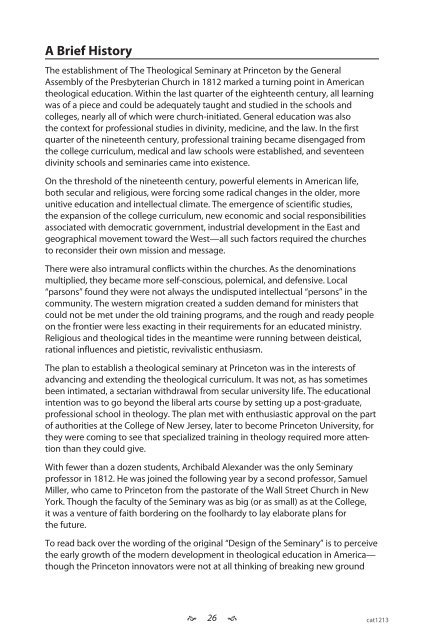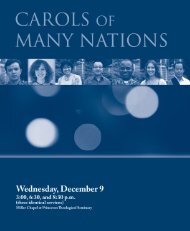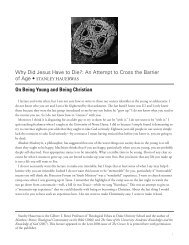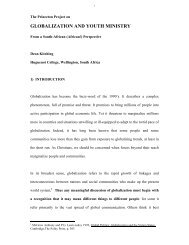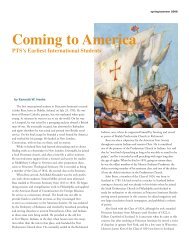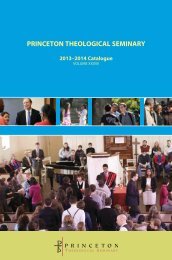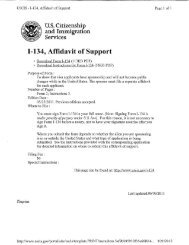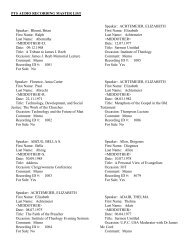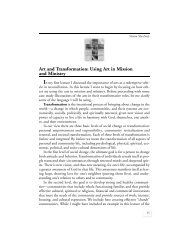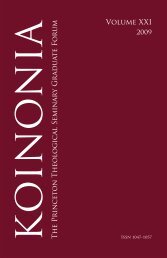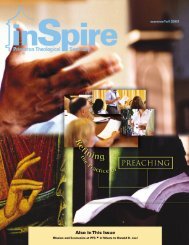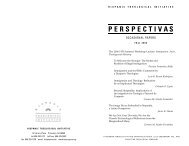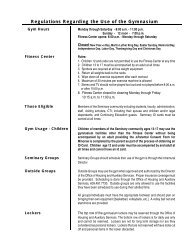PTS Catalogue - Princeton Theological Seminary
PTS Catalogue - Princeton Theological Seminary
PTS Catalogue - Princeton Theological Seminary
You also want an ePaper? Increase the reach of your titles
YUMPU automatically turns print PDFs into web optimized ePapers that Google loves.
A Brief History<br />
The establishment of The <strong>Theological</strong> <strong>Seminary</strong> at <strong>Princeton</strong> by the General<br />
Assembly of the Presbyterian Church in 1812 marked a turning point in American<br />
theological education. Within the last quarter of the eighteenth century, all learning<br />
was of a piece and could be adequately taught and studied in the schools and<br />
colleges, nearly all of which were church-initiated. General education was also<br />
the context for professional studies in divinity, medicine, and the law. In the first<br />
quarter of the nineteenth century, professional training became disengaged from<br />
the college curriculum, medical and law schools were established, and seventeen<br />
divinity schools and seminaries came into existence.<br />
On the threshold of the nineteenth century, powerful elements in American life,<br />
both secular and religious, were forcing some radical changes in the older, more<br />
unitive education and intellectual climate. The emergence of scientific studies,<br />
the expansion of the college curriculum, new economic and social responsibilities<br />
associated with democratic government, industrial development in the East and<br />
geographical movement toward the West—all such factors required the churches<br />
to reconsider their own mission and message.<br />
There were also intramural conflicts within the churches. As the denominations<br />
multiplied, they became more self-conscious, polemical, and defensive. Local<br />
“parsons” found they were not always the undisputed intellectual “persons” in the<br />
community. The western migration created a sudden demand for ministers that<br />
could not be met under the old training programs, and the rough and ready people<br />
on the frontier were less exacting in their requirements for an educated ministry.<br />
Religious and theological tides in the meantime were running between deistical,<br />
rational influences and pietistic, revivalistic enthusiasm.<br />
The plan to establish a theological seminary at <strong>Princeton</strong> was in the interests of<br />
advancing and extending the theological curriculum. It was not, as has sometimes<br />
been intimated, a sectarian withdrawal from secular university life. The educational<br />
intention was to go beyond the liberal arts course by setting up a post-graduate,<br />
professional school in theology. The plan met with enthusiastic approval on the part<br />
of authorities at the College of New Jersey, later to become <strong>Princeton</strong> University, for<br />
they were coming to see that specialized training in theology required more attention<br />
than they could give.<br />
With fewer than a dozen students, Archibald Alexander was the only <strong>Seminary</strong><br />
professor in 1812. He was joined the following year by a second professor, Samuel<br />
Miller, who came to <strong>Princeton</strong> from the pastorate of the Wall Street Church in New<br />
York. Though the faculty of the <strong>Seminary</strong> was as big (or as small) as at the College,<br />
it was a venture of faith bordering on the foolhardy to lay elaborate plans for<br />
the future.<br />
To read back over the wording of the original “Design of the <strong>Seminary</strong>” is to perceive<br />
the early growth of the modern development in theological education in America—<br />
though the <strong>Princeton</strong> innovators were not at all thinking of breaking new ground<br />
!# 26#"<br />
cat1213


